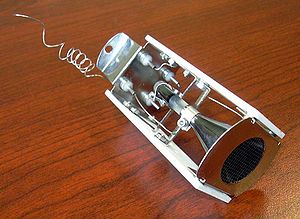
Electron multiplier
Encyclopedia

Secondary emission
Secondary emission in physics is a phenomenon where primary incident particles of sufficient energy, when hitting a surface or passing through some material, induce the emission of secondary particles. The primary particles are often charged particles like electrons or ions. If the secondary...
, a single electron
Electron
The electron is a subatomic particle with a negative elementary electric charge. It has no known components or substructure; in other words, it is generally thought to be an elementary particle. An electron has a mass that is approximately 1/1836 that of the proton...
can, when bombarded on secondary emissive material, induce emission of roughly 1 to 3 electron
Electron
The electron is a subatomic particle with a negative elementary electric charge. It has no known components or substructure; in other words, it is generally thought to be an elementary particle. An electron has a mass that is approximately 1/1836 that of the proton...
s. If an electric potential
Electric potential
In classical electromagnetism, the electric potential at a point within a defined space is equal to the electric potential energy at that location divided by the charge there...
is applied between this metal plate and yet another, the emitted electrons will accelerate to the next metal plate and induce secondary emission
Secondary emission
Secondary emission in physics is a phenomenon where primary incident particles of sufficient energy, when hitting a surface or passing through some material, induce the emission of secondary particles. The primary particles are often charged particles like electrons or ions. If the secondary...
of still more electrons. This can be repeated a number of times, resulting in a large shower of electrons all collected by a metal anode, all having been triggered by just one.
Operation
The avalanche can be triggered by any charged particle hitting the starting electrode with sufficient energy to cause secondary emission. Hence the electron multiplier is often used as an ion detector. It could also be triggered by a photon causing vacuum photoemission of at least one electron. In a photomultiplierPhotomultiplier
Photomultiplier tubes , members of the class of vacuum tubes, and more specifically phototubes, are extremely sensitive detectors of light in the ultraviolet, visible, and near-infrared ranges of the electromagnetic spectrum...
tube, a photo-emissive surface is followed by an electron multiplier with several sequential multiplying electrodes called dynodes. Because these electrodes are separate from each other, this might be called a "discrete-dynode" multiplier. A voltage divider chain of resistors is usually used to place each dynode at a potential 100-200v more positive than the previous one.
A "continuous-dynode" structure is feasible if the material of the electrodes has a high resistance, so that the functions of secondary-emission and voltage-division are merged. This is often built as a funnel of glass coated inside with a thin film of semi-conducting material, with negative high voltage applied at the wider input end, and positive voltage near ground applied at the narrower output end. Electrons emitted at any point are accelerated a modest distance down the funnel before impacting the surface, perhaps on the opposite side of the funnel. At the destination end a separate electrode (anode) remains necessary to collect the multiplied electrons. This structure is also known as (single) channel electron multiplier (CEM), and one of the most common is sold under the trade name Channeltron.
Another geometry of continuous-dynode electron multiplier is called the microchannel plate. It may be considered a 2-dimensional parallel array of very small continuous-dynode electron multipliers, built together and powered in parallel too. Each microchannel is generally parallel-walled, not tapered or funnel-like.
Applications
In mass spectrometryMass spectrometry
Mass spectrometry is an analytical technique that measures the mass-to-charge ratio of charged particles.It is used for determining masses of particles, for determining the elemental composition of a sample or molecule, and for elucidating the chemical structures of molecules, such as peptides and...
electron multipliers are often used as a detector of ions that have been separated by a mass analyzer of some sort. They can be of the continuous-dynode type, and may have a curved horn-like funnel shape, or they can have discrete dynodes as in a photomultiplier
Photomultiplier
Photomultiplier tubes , members of the class of vacuum tubes, and more specifically phototubes, are extremely sensitive detectors of light in the ultraviolet, visible, and near-infrared ranges of the electromagnetic spectrum...
.
See also
- Faraday cupFaraday cupA Faraday cup is a metal cup designed to catch charged particles in vacuum. The resulting current can be measured and used to determine the number of ions or electrons hitting the cup...
- Daly detectorDaly detectorA Daly detector is a gas phase ion detector that consists of a metal "doorknob", a scintillator and a photomultiplier. It was named after its inventor Norman Richard Daly. Daly detectors are typically used in mass spectrometers....
- PhototubePhototubeA phototube is a type of gas-filled or vacuum tube that is extremely sensitive to light in the ultraviolet, visible, and near-infrared ranges of the electromagnetic spectrum.-Operating principles:...
- Geiger counterGeiger counterA Geiger counter, also called a Geiger–Müller counter, is a type of particle detector that measures ionizing radiation. They detect the emission of nuclear radiation: alpha particles, beta particles or gamma rays. A Geiger counter detects radiation by ionization produced in a low-pressure gas in a...
- Scintillation counterScintillation counterA scintillation counter measures ionizing radiation. The sensor, called a scintillator, consists of a transparent crystal, usually phosphor, plastic , or organic liquid that fluoresces when struck by ionizing radiation. A sensitive photomultiplier tube measures the light from the crystal...
- Lucas cell
- Zoltán Lajos BayZoltán Lajos BayZoltán Lajos Bay was a Hungarian physicist, professor, and engineer who developed microwave technology, including tungsten lamps. He was the first person to observe radar echoes from the Moon...
(developer)

